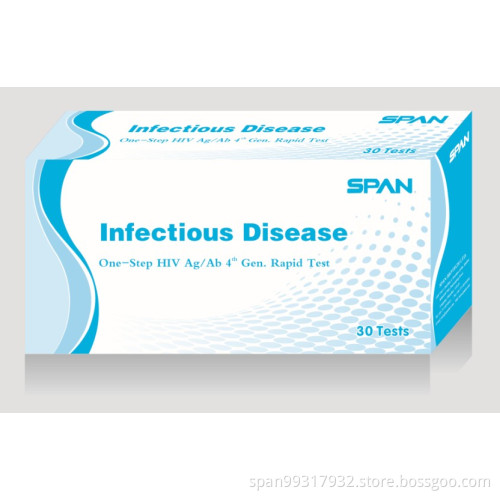
HIV(1+2) Ag/Ab Combo Test Kit (3 lines)
- Payment Type:
- T/T, Western Union
- Incoterm:
- EXW
- Min. Order:
- 2000 Piece/Pieces
- Min. Order:
- 2000 Piece/Pieces
- Delivery Time:
- 7 Days
- Transportation:
- Ocean, Air
Quantity:
Your message must be between 20 to 2000 characters
Contact NowBasic Info
Basic Info
| Place of Origin: | China |
|---|---|
| Productivity: | HIV Ag/Ab |
| Supply Ability: | HIV Ag/Ab |
| Payment Type: | T/T,Western Union |
| Incoterm: | EXW |
| Transportation: | Ocean,Air |
Product Description
Product Description
INTRODUCTION
The HIV (1+2) Ag/Ab combo rapid test kit is a rapid, qualitative test for the detection of HIV p24 antigen and antibodies to all isotypes
(IgG, IgM and IgA) specific to HIV-1 including subtype-O and/or HIV-2 simultaneously in human serum, plasma or whole blood. The
antigens are prepared with proteins to have HIV-1, gp41, gp120 and gp36. For HIV 2, p24 ab & gp36. TheHIV (1+2) Ag/Ab Combo
Test kit (3lines) is intended for professional use, only for aninitial screening test and reactive samples should be confirmedby a
supplemental assay such as ELISA or Western Blot test.
PRECAUTION
1. For in vitro diagnostic uses only.
2. Clean up spills thoroughly using an appropriate disinfectant.
3. Decontaminate and dispose of all specimens, reaction kits and potentially contaminated materials, as if they were infectious
waste, in a biohazard container.
4. Do not mix and interchange different specimen.
5. Anticoagulants such as heparin, EDTA and sodium citrate do not affect the test result.
6. Lcteric, lipemic, hemolysed, heat treated and contaminated specimens may give erroneous results.
7. Do not use test kit beyond expiration date.
SUMMARY AND EXPLANATION OF THE TEST
HIV (Human Immunodeficiency Virus) is recognized as the etiologic agent of Acquired immune Deficiency Syndrome (AIDS). The
virus is transmitted by sexual contact, exposure to infected blood, certain body fluids or tissues, and from mother to fetus orchild
during the perinatal period. HIV-1 has been isolated from patients with high potential risk of developing AIDS.
HIV-1 appears to be the most common one while HIV-2 is mostly found in patient samples from West African region. Its course is
marked by increasing levels of viral replication and the emergence of more virulent viral strains. This process causes the destruction
of the immune system. HIV infection is staged by CD4 cell counts and clinical symptoms. Not all people progress through all [stages"
and the time frames may also very greatly from person to person.







